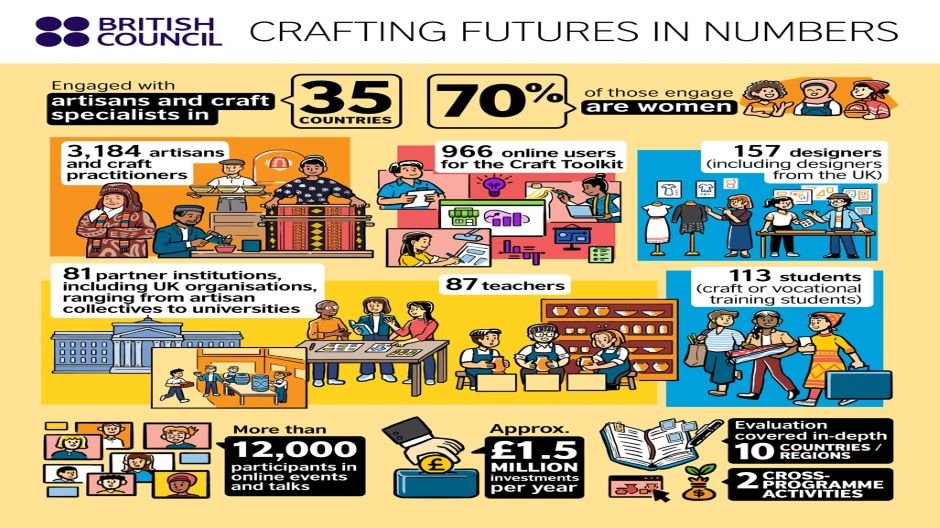
28 July 2022
by Sevra Davis
We are delighted to publish the final report covering three years of the Crafting Futures programme.
Crafting Futures is a global programme which aims to support a more sustainable future for crafts around the world and ensure that craft is appreciated for economic, social and environmental development.
The programme first began in 2017 with a few parallel craft-focused programmes and was formally established by the British Council’s Architecture Design and Fashion team in 2019 as a three-year programme running from 1 April 2019 through 31 March 2022. Since 2019, the programme, has engaged with artisans and craft specialists in 35 countries and 70% of those engaged are women. The programme has successfully supported them to develop their skills and boost their ability to earn more income. Due to the nature of the programme, it is difficult to quantify the exact investment in Crafting Futures, but a typical year in the three-year programme (in a non-pandemic year) with the programme working across multiple countries is approximately £1.5million and includes staff time both in the UK and around the world. The programme brings together craft practitioners, designers and organisations from around the world to explore possibilities for this future together. It provides education and training opportunities, connects artisans from rural communities with international designers, creates international partnerships and increases access to new markets and audiences.
The programme enables designers and artisans to develop their practices (including with technology), empowers them to create their own businesses, and improve their abilities to shape local craft markets and sell their products locally and internationally. Activities include residencies, hands-on workshops, creation labs, exhibitions, and discussions on design, fashion, entrepreneurship, indigenous knowledge and cross-cultural creation. The programme investigates environmental impacts, resource efficiency, health and safety, intellectual property rights and other key considerations.
Crafting Futures is tailored to the needs of the local communities, and its inclusive approach means it is open to craft practitioners of any background in any location.
The programme is currently active in 20 countries across East Asia, South Asia, Latin America and Wider Europe. The list of country projects presented in the report is a small selection of projects conducted in the context of Crafting Futures.
Overview of outcomes
The evaluation and final report show that the Crafting Futures programme has led to a wide range of positive changes across the countries where it has been implemented. A certain number of outcomes from the Theory of Change were evidenced by data collected by country projects, while others have not been validated by available data yet.
The first outcome area – individual participants – benefitted from the largest amount of data collected by country; as a result, the impact in this area is the most established. It is not necessarily surprising, as data collection in this area relied primarily on project participants, which is a common way of evaluating impact. Capturing impact on partners and system change proved to be more challenging.
The table below provides a simplified overview of our level of confidence that outcomes have been realised for each outcome area. It is worth noting that, for all impact areas, the breadth and quality of the data does not allow us to reach definitive conclusions about the medium and long-term impact of the project.
Outcome area
Level of confidence that outcomes have realised (High, Medium, Low)
Justification
1: Individual, enterprises, practitioners, students and teachers
High for short-term outcomes, medium to low for long-term outcomes
This outcome area benefits from the strongest evidence across all outcome areas. There is evidence that the programme contributed to increasing artisans, students and entrepreneurs’ capacities in the short-term; however, there is still limited data collected to show the medium and long-term sustainability of those outcomes.
2: Institutions and partners
Medium to low
Testimonials and surveys filled in by partners show the benefits they gained from the programme, but the evidence base on this is still relatively limited in terms of depth of evidence and sample size.
3: System Change
Medium to Low
There is solid evidence to show that the programme had an impact on systems (e.g. education systems) in two countries; however, there is limited evidence for the rest of the programme.
4: International Collaborations
Medium to Low
There is some evidence to show progress towards outcomes in this area, but it is not consistent across all countries and remains relatively limited.